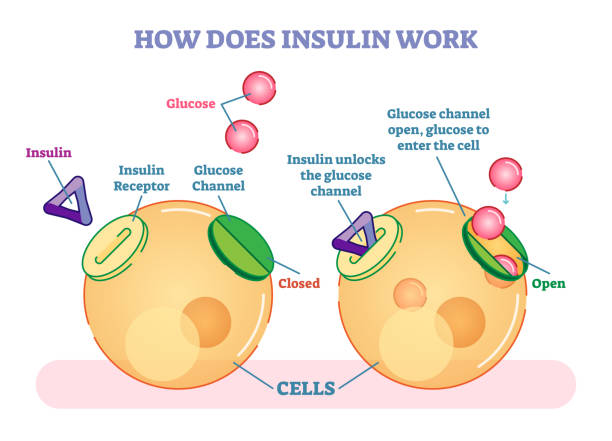Intro | Causes | Symptoms | Treatment | Types | Benefits | Recommended Resources | Free Consultation
Intermittent Fasting was first championed by Michael Mosley (1) who famously reversed his Type 2 Diabetes.
He did this by restricting his calorie intake on certain days.
Type 2 Diabetes is characterised by insulin resistance, but insulin levels and insulin sensitivity have a huge impact on our overall health and even our longevity.
There now exists a raft of research and new ideas concerning the impact of how much we eat and when we eat on our overall health and on our weight.
We cover these topics in more detail:
What is Intermittent Fasting?
Intermittent fasting is restriction of food for certain days or certain times.
It’s only recently we’ve had unrestricted access to food. We’re conditioned to believe we should always eat breakfast, have three square meals per day, with snacks in between if we feel hungry.
This has long been recommended by nutritionists.
So, what’s changed?
Nowadays it’s a cultural norm to eat breakfast, lunch and dinner.
We are conditioned to be intolerant to hunger – food is plentifully available everywhere, so why should we be hungry?
In days gone by it wasn’t so.
There would have been periods where food was abundant, and other occasions when times were lean.
Historians believe as civilisations developed, eating three meals per day became a reflection of affluence.
Farm workers and itinerant populations’ eating patterns varied with the seasons and may have included fasting at certain times, by necessity.
Our bodies may be hard-wired to this form of eating.
In Greek and Roman times, one single large meal per day was the norm, (link) with a very light breakfast of fruit or a biscuit for the men. Usually breakfast was frowned upon, because eating more than one meal per day was considered a form of gluttony.
Breakfast assumed more importance over the years as society became increasingly wealthy.
Some people believe this is due in a large part to the success of cereal advertising.
Intermittent fasting is exciting because recent research suggests it may reduce insulin resistance.
Let’s have a look at this hormone now.
What does insulin do?
Insulin is a hormone manufactured by the pancreas when your blood sugar rises after eating.
Insulin helps your body’s cells to absorb glucose from the blood and use it for energy.
Normally, you would have low levels of insulin circulating in your body, and they would only rise after eating.
What is Insulin Resistance?
Sometimes insulin frequently levels swing too high, especially if a lot of sugary foods are eaten.
Over time, our cells can fail to respond to insulin’s message, meaning sugar is not shunted into the cells and so blood sugar levels remain high.
The body reacts by pumping out more insulin to try to encourage the cells to listen.
This is termed insulin resistance.
When insulin resistance occurs, blood sugar is converted to fat, because high blood glucose levels are dangerous, and your body thinks your cells don’t need the sugar right now.
It’s simply stored away for later.
The higher your insulin levels, the harder it is to burn fat and lose weight, as your body constantly tries to shunt energy into your fat cells.
What causes insulin resistance?
If you eat a lot of sugar and processed carbohydrates, sugar is released quickly into the blood, causing the pancreas to release a rush of insulin.
This is a major factor in developing insulin resistance.
Think of it as someone who’s constantly emailing you or messaging you – in the end you’ll tend to ignore them.
It’s just the same with our cells and insulin.
Other culprits connected with developing insulin resistance include alcohol and caffeine, which both cause a rapid rise in blood sugar levels, soft drinks containing high-fructose corn syrup, and even too much stress, too little exercise and not enough sleep.
What are the symptoms of insulin resistance?
Symptoms of insulin resistance include fatigue, fat around the middle, bloating and fluid retention, dark patches of skin especially on the knees and elbows, sugar and carbohydrate cravings and fluid retention especially around the ankles.
Insulin resistance causes hormonal imbalance elsewhere, particularly of oestrogen, progesterone, and testosterone.
Can resistance to insulin be reversed?
When we fast, our blood sugar levels naturally reduce. The body has a short-term supply of energy – a savings reserve, if you like – which it stores in the liver and muscles as glycogen. After between 12 and 24 hours without food, stores of glycogen become depleted.
When these reserves run out, our body will switch to obtaining its fuel supply from burning off stored fat as an energy source – the biological equivalent of a hybrid vehicle. Insulin levels also reduce, and we will lose weight as we lose fat.
After a period of fasting, our body enters a state of ketosis.
The word “keto” refers to ketone bodies which are molecules which provide an alternative fuel for body cells.
They are used when blood sugar is in short supply. Ketones are produced from stored fat.
Although fasting will induce ketosis, the body also enters a ketosis when we eat very few carbohydrates. Ketosis was the basis of the low-carbohydrate Atkins diet.
Research suggests that fasting can improve or even reverse insulin resistance and break the cycle of high insulin and low insulin sensitivity.
What types of intermittent fasting are there?
Modified fasting
This is the original regime practised by Michael Mosey.
It involves eating 20-25% of the day’s ‘usual’ calories on scheduled fast days, usually on two days per week.
It is the basis of the 5:2 diet. (link)
Alternate day fasting
No food is eaten at all one day, with ad lib eating allowed the following day. The number of fast days per week can be varied.
Time-restricted feeding
This has gained popularity in recent years, mostly because it is the easiest type of intermittent fasting to fit into a daily routine.
In this type of fasting, you eat your normal daily food intake but in a short time period window.
Studies on time-restricted feeding have used fasting intervals of between 12 and 21 hours.
All studies reviewed resulted in increased insulin sensitivity and decreased fasting insulin levels.
The most popular regimens involve an 8-hour feeding window and 16 hours without food. The shortest feeding window reported to experience benefits appears to be fourteen hours.
Practically speaking, for most people this will mean having an early dinner and then skipping breakfast the following day.
Happily, one study found skipping breakfast not surprisingly meant subjects were hungrier earlier in the day, but they did not feel more hungry than usual later in the day.
Our circadian rhythm affects insulin sensitivity. Humans are generally more insulin resistant in the evenings.
Studies have found our insulin sensitivity decreases steadily throughout the day.
The release of growth hormone, which occurs at night, impedes insulin secretion.
When we eat at night our blood sugar levels increase more than they would eating an equivalent meal during the day. So it’s important to synchronise feeding with circadian rhythms.
To complicate the picture, our individual genetics means we all have different circadian rhythms, so the right time to eat will be personal to you.
Try to go without food for 12 hours occasionally to discover which timings suit you best, before increasing to three to four times per week.
If you have your last meal at 7PM, then you would not eat anything until 7AM the next morning.
If that seems really easy, increase the fasting window, perhaps by having your evening meal slightly earlier and your breakfast later.
Research has shown intermittent fasting can produce results in as little as two weeks.
One study looked at obese subjects with type 2 diabetes.
After two weeks, they reported an average of 1.39kg weight loss, and a morning glucose level which was on target.
There was a positive relationship between an increase in the number of hours fasted and fasting glucose values.
A recent review of studies concluded results have been mixed.
This is largely because they have differed greatly in terms of the type of fasting, with vastly different feeding regimes, calories eaten, weight and health of subjects, and the type of food given.
However, that said, 78% studies reported a significant weight loss, while half the studies demonstrated a decrease in fasting insulin and an improvement in insulin resistance.
What are the other benefits of Intermittent Fasting?
Other benefits reported include reduced cardiovascular disease markers and the promotion of autophagy.
This is when the body gets rids of damaged cells, toxins and waste products.
Studies have even shown our gut bacteria alter when we fast. A specific type of bacteria, known as Akkermansia flourishes when calories are restricted.
This type of bacteria strengthens our intestinal lining and helps to reduce inflammation. In studies, subjects who had high levels of Akkermansia lost more weight and belly fat when they dieted, and they had better blood sugar balance.
In another study, gut microbiota increased in diversity after a fasting programme of just one week.
Is intermittent fasting for everyone?
Concerns have been raised about the effect of ketosis on bone health, because it’s thought ketosis can acidify the blood.
This could mean alkalising minerals are drawn out of the bones to counteract the acidity. However, recent research has not supported this, although studies have used a very small sample size or relatively short time periods.
More research is needed on the effects of long-term intermittent fasting on postmenopausal women who are at an increased risk of bone loss due to hormonal changes at this time.
A recent study showed intermittent fasting can increase the likelihood of hypoglycaemia, otherwise known as low blood sugar.
Even though reducing high blood sugar levels is beneficial, hypoglycaemia can be dangerous.
For this reason, people with diabetes who are interested in trying out intermittent fasting should consult with their doctor first.
It’s interesting to note the vast majority of research has been carried out on male participants, which have mostly been rodents, or else studies have not differentiated between males and females.
Some experts argue calorie restriction in females can lead to sex hormone imbalance. Fasting tells the body not to be fertile, which brings about hormonal changes.
However, one study published in the journal ‘Metabolism’ used postmenopausal obese mice and found time-restricted feeding led to rapid weight loss, better insulin sensitivity and increased physical activity.
The participants, who has an 8-hour feeding window, had exactly the same diet as other mice who had access to food 24/7.
When should I eat to reverse insulin resistance?
Generally, best results are obtained when eating a Mediterranean type diet including moderate amounts of lean meat, oily fish and plentiful fresh vegetables and olive oil.
One of the main criticisms of intermittent fasting is that many people eat a lot of animal protein and poor-quality fats in an attempt to enter ketosis.
They will often eat very few fruits and vegetables.
A recent study found that increased mortality in adults in the USA over a 25-year period was connected with the percentage of energy from carbohydrate intake.
Those who ate 50-55% of their energy from carbohydrates had the lowest risk of mortality, but less than 40% calories from carbohydrates and more than 70% was related to a greater mortality risk.
However, these results varied according to the source of fat and protein – mortality increased when carbohydrates were substituted with animal-derived fat or protein, while mortality decreased when the swaps were plant-based.
So, it’s OK to reduce your carbs as long as you replace them with healthy plant protein and fats. Chapter 3 in the The Ultimate Guide to Carbs covers more on the topic of food and insulin.
What should I eat on non-fasting days?
The same – just it’s not restricted! If you fancy a treat, go for it, in moderation of course.
Schedule your fasting days around social commitments to make it easier to stick to.
So, if you’ve been curious about intermittent fasting, why not give it a try?
It’s a positive step you can make towards reducing your waistline, and your overall health will benefit too. Perhaps you’re convinced fasting is not for you – then try time-restricted fasting which is simple to fit into your daily routine.
Your body will thank you for it.
Helpful Resources:
-
Signs of Insulin Resistance – healthline.com
-
Symptoms of metabolic syndrome – NHS.uk
-
Can insulin resistance be reduced or reversed? – diabetes.co.uk
-
Reverse Insulin Resistance with Intermittent Fasting – bulletproof.com
- Who is Michael Mosley?
More Fasting Related Stories from our Blog:






